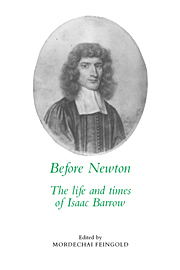Book contents
- Frontmatter
- Contents
- List of contributors
- Editor's preface
- 1 Isaac Barrow: divine, scholar, mathematician
- 2 The Optical Lectures and the foundations of the theory of optical imagery
- 3 Barrow's mathematics: between ancients and moderns
- 4 Isaac Barrow's academic milieu: Interregnum and Restoration Cambridge
- 5 Barrow as a scholar
- 6 The preacher
- 7 Isaac Barrow's library
- Index
2 - The Optical Lectures and the foundations of the theory of optical imagery
Published online by Cambridge University Press: 05 November 2011
- Frontmatter
- Contents
- List of contributors
- Editor's preface
- 1 Isaac Barrow: divine, scholar, mathematician
- 2 The Optical Lectures and the foundations of the theory of optical imagery
- 3 Barrow's mathematics: between ancients and moderns
- 4 Isaac Barrow's academic milieu: Interregnum and Restoration Cambridge
- 5 Barrow as a scholar
- 6 The preacher
- 7 Isaac Barrow's library
- Index
Summary
Introduction
Isaac Barrow completed a major phase of the Keplerian revolution in geometrical optics by creating a mathematical theory of optical imagery. In the opening years of the seventeenth century Kepler had introduced the new concepts of pencil of rays and of image formation by pencils and thereby laid the foundation, even if largely qualitative, of the modern theory of image formation in lenses and optical systems. He then applied these new ideas to the optical system of the eye; and with his discovery that vision occurs by means of a real inverted image formed on the retina, he created an entirely new theory of visual perception. Telescope design and construction, studies of vision, and a search for the true law of refraction were vigorously pursued in the decades following Kepler's pioneering research, but the mathematical investigation of optical imagery languished. Not until midcentury was a solution provided to even such an elementary problem as the determination of the focal point of thin spherical lenses. Barrow's principal achievement was to determine the location of the image after any reflection or refraction in plane and spherical surfaces. By synthesizing and reformulating a number of Keplerian concepts, he created the mathematical foundation of a general theory of optical imagery and, with his concept of oblique pencils of rays, began the exact study of astigmatism and caustics.
Barrow's Optical Lectures is devoted almost exclusively to a single subject, the mathematical theory of image location. Barrow strays from it only in the opening two lectures on physical models of light and in some brief remarks on color.
Information
- Type
- Chapter
- Information
- Before NewtonThe Life and Times of Isaac Barrow, pp. 105 - 178Publisher: Cambridge University PressPrint publication year: 1990
Accessibility standard: Unknown
- 7
- Cited by
